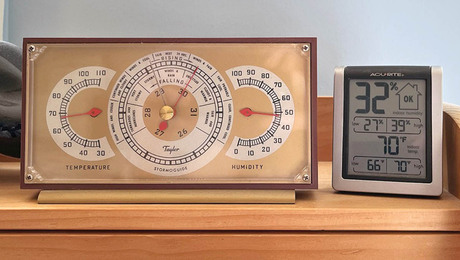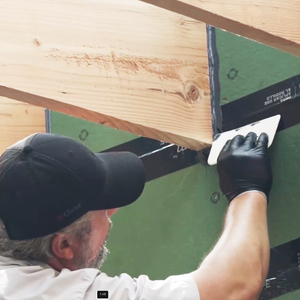| Plan on installing a walkway here in Michigan. Can’t deciede between brick pavers or a stamped concrete. The walk will be approx. 2 1/2′ wide and approx. 70′ long and a curve to it. I would do both work myself, I have done a number of sidewalks, but not the stamped. What are some of the pro’s & con’s of both type of walks. |
Discussion Forum
Discussion Forum
Up Next
Video Shorts
Featured Story

Source control, ventilation, and filtration are the keys to healthy indoor air quality. Dehumidification is important too.
Highlights
"I have learned so much thanks to the searchable articles on the FHB website. I can confidently say that I expect to be a life-long subscriber." - M.K.

















Replies
Good pavers won't crack from the freeze thaw cycle.
Weeds and other green matters will sprout from between the paver joints from seeds landing on the surface.
It's been intersting observing the 12x30 brick paver patio I installed three years ago, which is under a pergola and open to the weather.
I used paver bricks so they can be taken up easily if the need ever arises.
I haven't done stamped concrete, but I have installed brick pavers.
Two and a half feet wide is narrow for a walk that people will use as a primary walkway, say, for guests to use to the front door. But it's nice for a pleasure path, in a garden, for example.
In my opinion the primary advantage of pavers is aesthetics. If the architecture and the setting call for the look of pavers then really nothing else will top off a project like a brick paved path. Guests will actually stop and peruse a first class brick paving job, but don't say as much with concrete.
As the ground moves with freeze/thaw cycles, properly installed pavers still retain an attractive look and age gracefully. Concrete slabs can become disjointed. Concrete always looks worse with age -- quickly if installed poorly, slowly if installed well. I've seen pavers still look good after 100 years. If either is installed poorly, either will look bad in only a few years.
Genuine fired clay pavers (as opposed to cementitious pavers) have a look that cannot be duplicated.
Concrete is easier and faster to install. Much less skill and labor are involved. Layout is more flexible. Concrete will tolerate a flimsier, less well compacted base better than pavers.
Pavers involve much more layout, kind of like laying tile, if you want, say both ends to have whole brick instead of slivers, and all your course lines straight. There's a lot of work cutting and fitting curves. It's hard on the hands, both on the skin of the finger tips, and on the muscles. A single day of placing brick can cramp your hands up so badly you can't move your hands that night. Moving tons of brick around the site, even from one end of a 70' path to the other, is a lot of work. You also will have the expense of a diamond saw for the duration of the placement.
But, fussing over the layout of every single brick is part of the pleasure of the job if you're anally-retentive.
I can email you some construction pictures of a nice brick path if you want.
Thanks for your reply, I am leaning towards the brick pavers, petty much for all the same reasons you mentioned. I am looking at the tumbled cobblestone look, purchased from a brick supplier, not a home cheapo quality. The walk will branch of our main 6' sidewalk to the front door and leed to a rear deck/entrance. So I felt that that width should be ok, just the width of my snow blower. I have always heard here in Michigan we have 2 kinds of concrete, that with cracks in it and concrete thats about to crack.
Every house on our street has concrete pavers. I had my heart set on impressed concrete for our driveway, c/w hydronic heat snow-clearing: there are a few around the neighbourhood and most look spectacular. But, I got talked out of it because of the high replacement cost in the off-chance it cracked. Next decision was a toss-up between tumbled Belgian blocks or cobblestones. Went with variable hue cobblestones with three sizes in a semi-random pattern: there wasn't enough differennce in appearance to go with the tumbled cobblestones; on the larger blocks, tumbling is well worth the extra cost..
Phill Giles
The Unionville Woodwright
Unionville, Ontario
Pavers, for all the reasons above, particularly WAYNEL5s. Freeze/thaw on concrete has a terrible effect over time, and in my opinion, always looks worse.
I built a walk and a round patio with 1,500 brick pavers about fifteen years ago and every year I lose maybe two or three to the freeze thaw cycle. (Maine coast) Paid top dollar and they are beautiful. I'd advise buying some extras for patching in over the years and maybe some in case you decide to expand your walk.
The bricks are going to move some, and shoveling snow can turn into an annoying chore if they get uneven, but the snowblower rumbles over them easily. So far I haven't run a brick through the blower. (Just a couple of my wife's patio lights!)
oldfred
If you use brick pavers make certain they are twice fired Clay! do not accept the cemment version. Twice fired clay will last nearly forever. Cement versions are rough looking after 5 years or so and sooner if you salt the snow off..
Cement is a much shorter lasting surface, it really needs a good base and seldom actually gets it.. thus there is all sorts of ways to short cut cement and unless you know and really insist on the full level of work it will not last.
PS south of the mason Dixon line forget it and do what you want!
I have installed both at my home in the Chicago area.
Pavers have a much nicer visual appeal, IMO. But large spaces or areas that need frequent shoveling can be expensive and problematic. Since your space is relatively small, pavers sound like the ticket.
If you choose stamped concrete. i suggest a seemless pattern. Much more believable than most other patterns out there. Also, i would recommend doing some test pours first. Since I formed, poured and stamped my own I first poured (2) 4x4 samples. This gave me a chance to tesat color combinations and stamping technique.
Stamped concrete, 18 x 18, is about three bucks something a piece in this area, and it always cracks along the seam if not laid properly. Plus, it always signals what it is -- HD cheap. On the other hand, century old Purington pavers can be had for 80 cents to a buck each, if you're not too picky about them being perfect. About eight bucks at most for the same dimension, and they're four inches thick. Never wear out in your lifetime. The picture at http://www.historicalbricks.com/project_gallery/gallery_v2.html is hard to resist.
To me stamped concrete means a concrete slab with the pattern stamped in it on site. See attached pic. Not some patio blocks that are bought at the store....Matt
I have installed both:
Stamped concrete (actually I have had it installed) - be aware that it must be sealed with a special sealer after installation, and it must be resealed every 2 years or so. It's almost like a lacquer based product. It doesn't really snow much where I live, but personally, I wouldn't take a snow shovel to it, for fear of damaging the sealed surface. The rubber stamps are not cheap. Around $100 - $200 each, and you need several. Also you will need control joints in the slab. They are normally cut in with a diamond saw on day 2 or day 3 of the installation process. Stamped concrete may be better be left to someone who specializes in it.
Pavers: Plan your project so that there is as little cutting as is possible. Or plan on spending many hours cutting brick. Cutting good pavers is a slow process even with a heavy duty diamond wet saw. Base prep is all important. You must rent a gas powered compactor, or maybe even 2 depending on your site conditions. At least a vibratory plate compactor and maybe a jumping jack. Compact the base well. I use ABC gravel (sometimes called crusher run). Create a hard edge to keep the edge bricks from coming loose. I like setting pavers on gravel screenings, with a bit of dry cement or mortar mixed in. A thin layer of sand works OK too, but again, I like mixing in a bit of dry cement. After the pavers are laid, cover them with masonry sand, and run a vibratory plate compactor over them to shake them down tight.
A general comment: as said above, 2.5' is too narrow for the entry walk to a home. 3.5 is minimal, and 4' allows people to easily walk in pairs.
Matt, with all comments take in, you are correct, leave the stamped concrete to an professional. I plan on the brick pavers for that reason. This walkway branches of the main 6' wide entrance to the front door of the house. The walk will lead to a garden area and back yard deck. We already have a 2 1/2' concrete walk on the other side of the house, that width seem to be ok. This new walk probly will end up @ 3', then replacing the other concrete at a later date to match. Thanks
Have used both. Pavers will last almost for ever, but do require some maintainence. We have a stamped driveway in Oak Brook, Il, that's 18 yearsold. It is a black cobble stone pattern, with the grade cut to clay, backfilled with Ca6, poured 5" thick w/6x6 wire. Very few cracks have appeared, they don't show in black, there has been some minor damage from snow removal. I believe the another principle reason for it's good service however, is keeping the garbage trucks off it.
cutting the brick pavers
Hi,
I am putting in a small walkway in a herringbone pattern using old Purington pavers. They are almost 4 inches thick and wide and about 9 inches long. To do the herringbone, I will have to cut a lot of triangular pieces. These bricks are pretty tempered so I am curious as to the best way to cut them. Any advice is greatly appreciated.
Regards,
Darryl